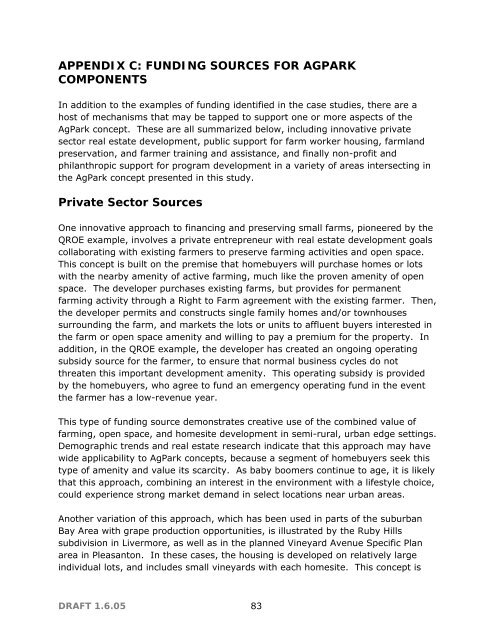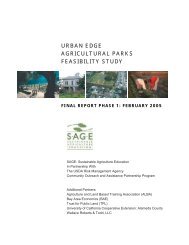A Feasibility Study for Urban Edge Agricultural Parks - SAGE
A Feasibility Study for Urban Edge Agricultural Parks - SAGE
A Feasibility Study for Urban Edge Agricultural Parks - SAGE
You also want an ePaper? Increase the reach of your titles
YUMPU automatically turns print PDFs into web optimized ePapers that Google loves.
APPENDIX C: FUNDING SOURCES FOR AGPARKCOMPONENTSIn addition to the examples of funding identified in the case studies, there are ahost of mechanisms that may be tapped to support one or more aspects of theAgPark concept. These are all summarized below, including innovative privatesector real estate development, public support <strong>for</strong> farm worker housing, farmlandpreservation, and farmer training and assistance, and finally non-profit andphilanthropic support <strong>for</strong> program development in a variety of areas intersecting inthe AgPark concept presented in this study.Private Sector SourcesOne innovative approach to financing and preserving small farms, pioneered by theQROE example, involves a private entrepreneur with real estate development goalscollaborating with existing farmers to preserve farming activities and open space.This concept is built on the premise that homebuyers will purchase homes or lotswith the nearby amenity of active farming, much like the proven amenity of openspace. The developer purchases existing farms, but provides <strong>for</strong> permanentfarming activity through a Right to Farm agreement with the existing farmer. Then,the developer permits and constructs single family homes and/or townhousessurrounding the farm, and markets the lots or units to affluent buyers interested inthe farm or open space amenity and willing to pay a premium <strong>for</strong> the property. Inaddition, in the QROE example, the developer has created an ongoing operatingsubsidy source <strong>for</strong> the farmer, to ensure that normal business cycles do notthreaten this important development amenity. This operating subsidy is providedby the homebuyers, who agree to fund an emergency operating fund in the eventthe farmer has a low-revenue year.This type of funding source demonstrates creative use of the combined value offarming, open space, and homesite development in semi-rural, urban edge settings.Demographic trends and real estate research indicate that this approach may havewide applicability to AgPark concepts, because a segment of homebuyers seek thistype of amenity and value its scarcity. As baby boomers continue to age, it is likelythat this approach, combining an interest in the environment with a lifestyle choice,could experience strong market demand in select locations near urban areas.Another variation of this approach, which has been used in parts of the suburbanBay Area with grape production opportunities, is illustrated by the Ruby Hillssubdivision in Livermore, as well as in the planned Vineyard Avenue Specific Planarea in Pleasanton. In these cases, the housing is developed on relatively largeindividual lots, and includes small vineyards with each homesite. This concept isDRAFT 1.6.05 83





